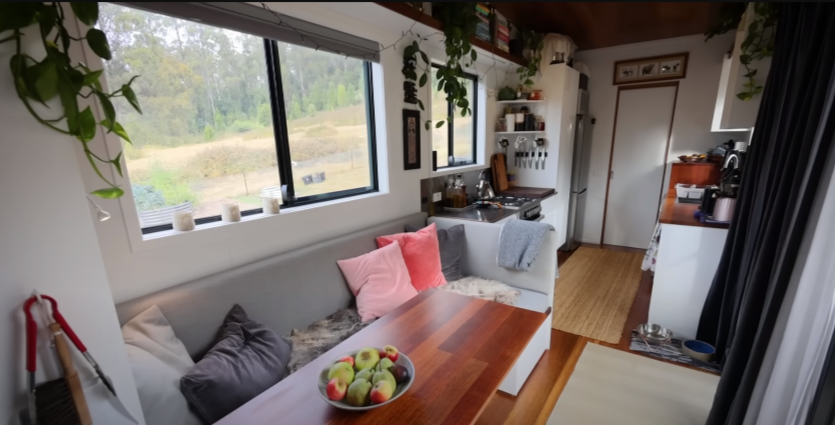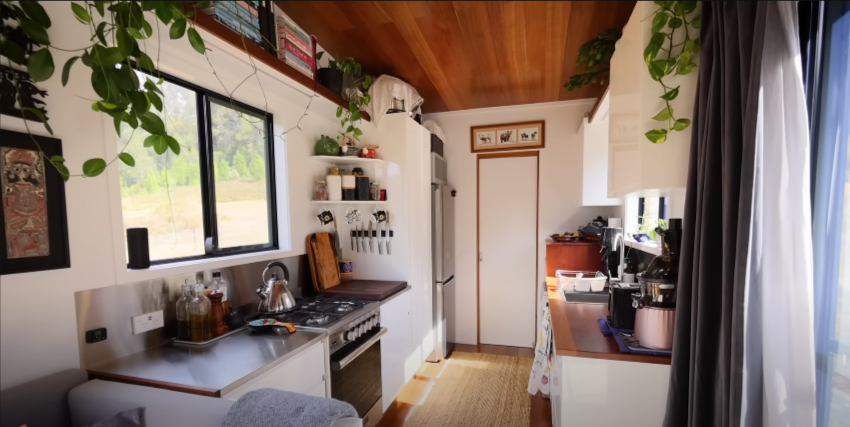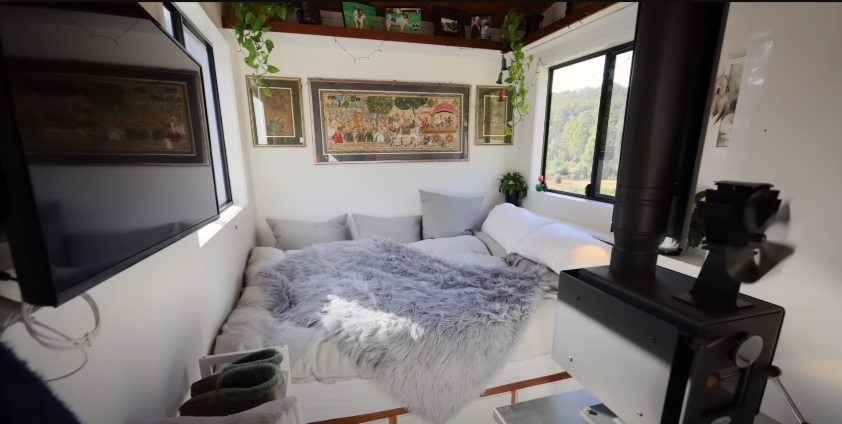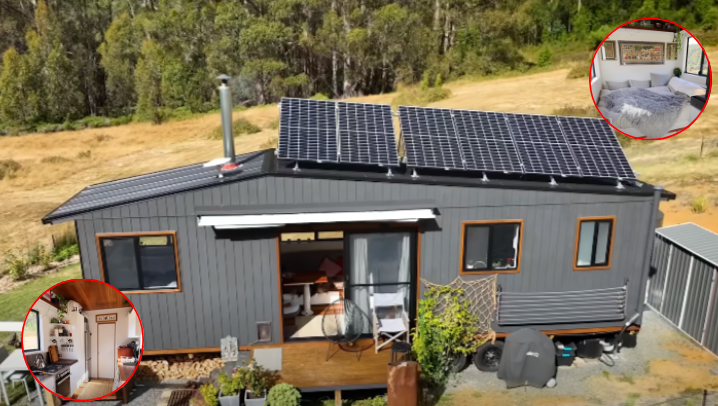When we think about living off the grid in a tiny house, the idea often resonates with themes of freedom, adventure, and a break from conventional norms. It’s about carving a life that’s a little different, a little simpler, and perhaps a lot more meaningful. Nestled in the wilderness of Tasmania, Anna has embraced this lifestyle with open arms. Her story is one of courage, inspiration, and a deep connection to nature.
A Dream Takes Shape
Anna’s journey to tiny house living started almost on a whim. “It was a spur-of-the-moment decision,” she recalls. A friend’s plan to build a tiny house reignited her own long-held fascination with minimalistic living. Like many others, she found herself grappling with the rising costs of housing while renting a three-bedroom home. Intrigued, Anna began researching builders online and found a local company in Tasmania. A serendipitous connection with the builders led to her signing the dotted line almost immediately.
“They had a Scandinavian style that resonated with my heritage,” says Anna, originally from Sweden. Her decision was cemented when the builders offered a trailer ready for a new project after a previous client’s plans fell through.
From that moment, Anna was on her way to designing and living in a home that was uniquely hers.
The Joy of Letting Go
One of the most liberating aspects of Anna’s transition was decluttering. “I realized I had way too much stuff, and it weighed me down,” she shares. The process of letting go was cathartic. Each load of items given away or recycled lightened her spirit. Today, Anna lives with only the essentials and hasn’t missed a thing.
The minimalist approach is deeply tied to Anna’s Scandinavian roots, where the philosophy of “less is more” prevails. Her tiny house is not just a place to live but a sanctuary where she feels free and unburdened.
Finding the Perfect Spot
Parking a tiny house can be a challenge, especially for those looking to live off-grid. For Anna, finding her idyllic spot was a stroke of luck. Just weeks before her house was completed, she was introduced to a local landowner. “Within hours, I visited the site and made arrangements. It was perfect,” she beams. Surrounded by greenery, the location provided Anna with the solitude she desired and the opportunity to cultivate her own garden.
Her tiny homestead is a work in progress, but Anna’s connection to the land is palpable. She enjoys digging into the soil, planting flowers, and growing fruits and vegetables, envisioning a future where she reaps the rewards of her labor.

Off-Grid Living: A Learning Curve
Anna’s tiny house is completely off the grid, a first for her. It’s equipped with solar panels, a composting toilet, and a rainwater tank. While living off-grid offers freedom, it also presents unique challenges. Anna admits, “The first winter was tough. I had to get a generator and learn to manage my energy consumption carefully.”
By removing a few trees to improve solar efficiency and adopting energy-conscious habits, Anna has made significant adjustments. The experience has heightened her awareness of her environmental footprint and deepened her appreciation for the resources she uses.
Scandinavian Aesthetic Meets Functionality
Anna’s tiny house reflects her Swedish heritage with its Scandinavian-inspired design. The exterior boasts a classic black finish with timber accents that blend seamlessly into the natural surroundings. Inside, the house is bright, cozy, and meticulously planned.
“I designed this home for me,” Anna explains, emphasizing that every detail was chosen with her needs in mind. Unlike many tiny houses with lofted sleeping areas, Anna opted for a single-level design. “I’m no spring chicken anymore, and the idea of climbing stairs didn’t appeal to me,” she laughs.
Her open-plan bedroom features a queen-sized mattress surrounded by windows, offering breathtaking views of the stars at night and the sunrise in the morning. The room doubles as a lounging area, complete with a rotating arm for her TV.
A Kitchen Made for Cooking
For Anna, the kitchen was a priority. “I love to cook, so I wanted a proper stove, oven, and even a dishwasher,” she says. The galley-style kitchen features full-sized appliances, a blend of stainless steel and timber countertops, and ample storage. Anna’s pantry is a particular favorite, offering the perfect balance of accessibility and organization.

Cozy Living Spaces
Anna’s living room is both functional and inviting. Her L-shaped couch provides a comfortable spot to relax or host guests. A cleverly designed table, bolted to the floor but movable, doubles as a dining and workspace.
“I work from home full-time, so having a space that transforms was essential,” Anna explains. Deep cushions and warm lighting create a cozy atmosphere, making the space feel anything but cramped.
Bathroom Bliss
The bathroom in Anna’s tiny house is both practical and stylish. The standout feature is her towel storage—a vertical rack that not only saves space but adds a soft, aesthetic touch to the room. A large shower with low-maintenance aqua panels and a composting toilet round out the space, aligning perfectly with Anna’s off-grid lifestyle.

Challenges and Rewards
Living in a tiny house has its challenges, particularly when it comes to managing off-grid systems. “You become very aware of your energy usage,” Anna says. But these challenges pale in comparison to the rewards. The simplicity and intentionality of tiny house living have brought Anna a profound sense of peace and fulfillment.
The Cost of Freedom
Building her tiny house and setting up off-grid systems cost Anna around $160,000—a price she considers well worth it. The investment has given her not just a home, but a lifestyle that aligns with her values and aspirations.
Looking Ahead
Anna’s tiny house journey is far from over. She dreams of extending her deck, adding a pergola, and expanding her garden. Perhaps there will even be room for chickens or goats in the future. Her vision is to create a tiny homestead that offers both sustainability and serenity.
A Life Reimagined
Anna’s story is a testament to the transformative power of tiny house living. By embracing minimalism and off-grid living, she has created a life that is not just sustainable but deeply enriching. Surrounded by nature, growing her own food, and living intentionally, Anna has found a freedom and joy that many only dream of.
Her journey reminds us that sometimes, the path to a better life begins with a bold decision to let go and embrace the unknown. For Anna, that decision has led to a life filled with adventure, beauty, and a profound connection to the world around her.
FAQs
1. What is off-grid living?
Off-grid living means being independent of public utilities such as electricity, water, and sewage. Instead, individuals rely on alternative energy sources like solar power, rainwater collection, and composting systems.
2. How much does it cost to build a tiny house for off-grid living?
Costs can vary widely depending on size, materials, and off-grid systems. In Anna’s case, her tiny house and off-grid setup cost approximately $160,000. However, simpler designs can be built for much less.
3. What are the key challenges of off-grid living?
- Managing energy consumption, especially during low-sunlight seasons.
- Learning to use and maintain alternative systems like composting toilets and rainwater tanks.
- Finding a suitable location to park your tiny house.
4. How do you find a location for a tiny house?
Options include leasing land, purchasing property, or negotiating with local landowners. Ensure the site meets your needs for water, sunlight, and access while complying with local zoning laws.
5. What are the benefits of off-grid living?
- Reduced utility bills.
- A lower environmental footprint.
- Greater self-sufficiency and connection to nature.
- Simplified, intentional living.
6. Can you live comfortably in a tiny house year-round?
Yes, with proper planning and design. Features like good insulation, energy-efficient appliances, and weatherproofing make year-round living comfortable.
7. How do off-grid systems work in a tiny house?
- Solar panels generate electricity for lights, appliances, and charging devices.
- Rainwater tanks collect water for household use, often with filtration systems.
- Composting toilets manage waste sustainably without plumbing.
8. Do tiny houses have enough storage space?
Storage in tiny houses is carefully designed to maximize efficiency. Built-in cabinets, multi-functional furniture, and decluttering are key to maintaining a tidy, functional space.
